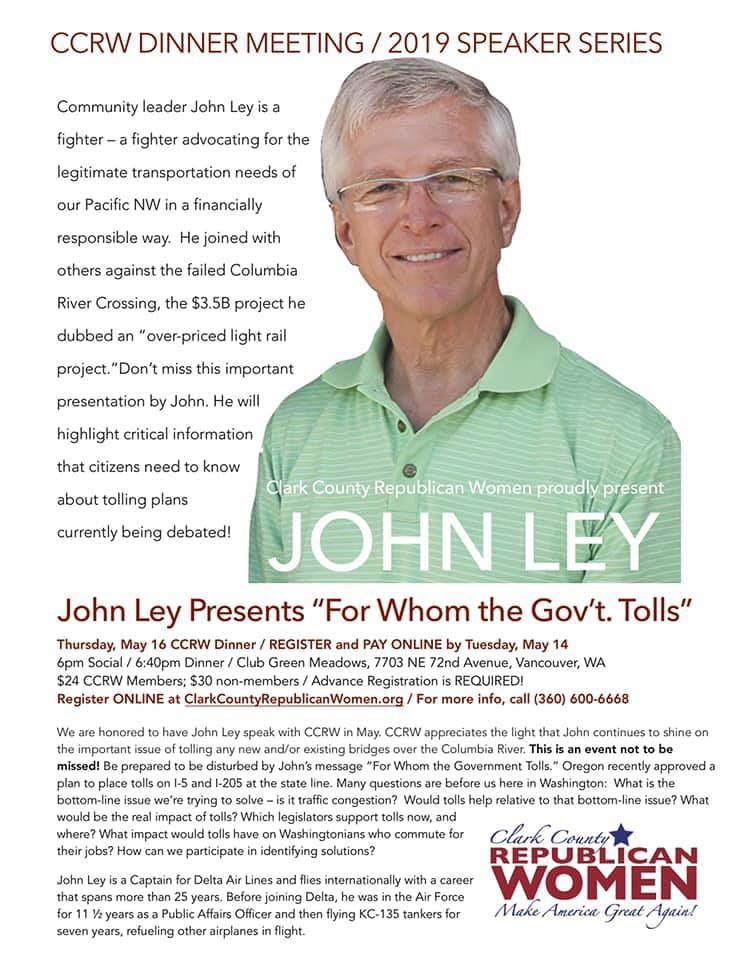Camas resident John Ley offers his thoughts on the outrageous cost of bonding toll revenue
In the 2019 Democrat-controlled Washington State Legislature, HB 2132 and SB 5825 were passed. The legislation will allow the state to bond and borrow up to $1.5 billion in future toll revenue from Wall Street banks. Voting in favor of this legislation, locally, were Senator Annette Cleveland and Representatives Sharon Wylie and Monica Stonier, all representing the 49th Legislative District.

The alleged purpose was to accelerate the construction of three “much needed” transportation projects in the Puget Sound area. Senate Bill 5825 primarily authorizes the expansion of tolling on I-405 and SR 167. It was the need for “immediate gratification” driving the legislature’s decision to live on the taxpayers credit card and allow bonding of future toll revenues.
Current tolling revenues will not cover a $1.5 billion debt. Picking the pockets of vehicle drivers will have to triple current toll revenues to cover borrowing $1.5 billion from Wall Street.
The Tacoma News Tribune reported it this way. (https://www.thenewstribune.com/opinion/article229737984.html?fbclid=IwAR0gy9aRrrvp_KFO_UPBtWozRt7sDsbETfcFyxgZCe75nB8cHs8g0j3l7NU).
“WSDOT is heading down this path and there is no turning back. The Senate approved the enabling legislation, Senate Bill 5825, by just one vote.
Under this plan, only about half of your toll (tax) dollars will be available to fund the promised projects once you deduct the 30 percent for collection and 12 to 16 percent financing costs of the bonding. That is not the most responsible use of your tax dollars.
Also, once tolls are bonded, there’s no incentive to reduce congestion – because that could reduce the revenue stream and affect the bond payoff.”
There are a host of reasons to be concerned, and Senator Fortunato nails it.
The Washington Policy Center also highlighted the issue (https://www.washingtonpolicy.org/publications/detail/toll-bill-would-set-us-up-for-gridlock-and-debt-for-decades), saying bonding would insure “gridlock and debt for decades.”
“The House bill would take the tolls that drivers pay and use them to borrow more money and send our state further into debt. Specifically, the bill would let WSDOT officials issue a whopping $1.5 billion in bonds backed primarily by the toll revenue drivers would be forced to pay on I-405 and SR 167.”
Currently, Washington Department of Transportation (WSDOT) tolls I-405 on the eastside of Seattle, on the northern half of I-405 from Bellevue north to Lynnwood, as well as parts of SR 167. The legislature hopes to expand tolling to the rest of I-405 by 2025 and more of SR 167 in 2026. See graphic below.
Graphic courtesy of WSDOT Tolling Division Annual Report
The 43 percent “Cost of Collection”
The Washington State Tolling Division in its 2018 Annual Report indicated that I-405 tolling took in $27.8 million last year. Of those gross “revenues,” they spent $11.9 million in tolling facility and operations maintenance costs, leaving a “net” of $15.9 million to buy new traffic lanes and fund other transportation improvements. The important thing to realize is that 43 percent of drivers’ tolling dollars go towards the “cost of collection” and maintaining the tolling facilities. What a huge waste of your money.
Graphic courtesy of WSDOT Tolling Division Annual Report
The Washington State Transportation Commission answered a public records request in early 2018. They indicated that 35 percent of I-405 toll revenues were going to the “cost of collection” of tolling facilities and the private firms that install and operate them on behalf of WSDOT. That 35 percent number mirrors the 3-year record of I-405 TOLL revenue being $75 million, and $25 million going to the cost of operating the tolling facilities, as reported by the WSDOT Tolling Division.
SR-167 improvements were added to the SB 5825 bonding measure. In 2018, WSDOT took in $3.4 million in SR-167 toll revenue (http://www.wsdot.wa.gov/sites/default/files/2018/11/13/Toll-167HotLanesFinancials-4thQuarterFY2018.pdf). Expenses were $1.5 million, for a 44 percent cost of collection on SR 167.
Borrowing $1,500,000,000 vs. collecting $25 million per year
With “income” of toll dollars taken from the pockets and budgets of thousands of Puget Sound drivers providing $25 to $30 million a year in funds, how long will it take to raise $1.5 billion? Because the legislature voted to expand the miles of freeway that can be tolled, toll dollars will increase by some unknown amount. Here are some numbers indicating that it will take a significant increase in annual tolling dollars (higher rates and more cars paying) plus a very long time, to collect the $1.5 billion the legislature is allowing WSDOT to borrow on behalf of taxpayers.
Graphic created of John Ley
It will take 30 years to collect $1.5 billion in gross toll revenue if tolling revenues double to $50 million per year. It will take 20 years to collect $1.5 billion in gross toll revenue if tolling revenues triple to $75 million per year.
What about interest on the $1.5 billion debt?
We all understand that buying a $30,000 car on credit means the total cost of the car will be more than $30,000. A 5 year loan at 5 percent means the owner will pay $33,968 for the car. Similarly, someone borrowing $300,000 to buy a home will pay $515,609 over 30 years with a 4 percent mortgage.
What will be the cost of borrowing $1.5 billion?
The legislatures “choice” to live on the citizens credit card means the new roads and lanes built, the new bridges built or repaired, will cost a great deal more. How much? It will require a two-step analysis.
We know it will take at least 30 years to raise $1.5 billion if annual tolling revenues double to $50 million per year, or at least 20 years if annual tolling revenues triple to $75 million per year.
Graphic created of John Ley
Buying $1.5 billion transportation projects on the taxpayer’s credit card means “if” the state has to pay 4 percent interest, it will require $85.9 million per year to pay off the loan. Furthermore, the total cost of the transportation projects WSDOT “buys” will rise by over $1 billion in interest to $2.57 billion.
As demonstrated earlier, tolling revenues would have to rise by roughly triple current amounts to generate the $86 million a year required to pay the loan.
The tolling nightmare as a source of funding
Tolling as a source of taxpayer “revenue” has a huge cost to collect that revenue. As shown, WSDOT loses 43 percent of tolling dollars collected on I-405, as the “cost of collection.” Therefore the “net” to pay off loans is only 57 percent of tolls collected.
One would expect politicians and bureaucrats to argue collection costs will go down, due to “economies of scale” when they expand the miles of roads being tolled. Here are the final tolling dollars that need to be collected from taxpayers to pay back the $1.5 billion in borrowed funds, with both a 43 percent “cost” of collection, and a 35 percent “cost of collection.”
Graphic created of John Ley
Because of the huge inefficiency in the tolling “cost of collection,” the $1.5 billion in borrowing results in those transportation projects costing $4.5 billion over a 30-year period. That is “if” tolls collected more than triple so annual revenues go to $86 million per year, assuming the “cost of collection” remain 43 percent with a 4 percent interest rate.
If those costs of collection drop to 35 percent, then the total cost of those transportation projects rises to $3.96 billion over 30 years, assuming the toll revenues more than triple.
With current I-405 TOLL revenues and SR-167 revenues totaling just over $30 million a year, that would limit borrowing to around $500 million, much less than the authorized $1.5 billion.
Bottom line to this discussion, is the legislation authorizes the bonding of toll dollars of $1.5 billion. That means whatever WSDOT “buys” with the borrowed money, taxpayers will be paying between $4 billion and $4.5 billion.
By comparison, our traditional means of funding transportation improvements is via the gas tax. The cost of collection is just under 1 percent. Under a “pay as you go” scenario, using gas tax dollars would mean drivers would pay only about $1.52 billion.
Doesn’t it make sense to pay a 1 percent “cost of collection” rather than a 43 percent “cost of collection? Doesn’t it make sense to pay $1.52 billion for these transportation projects rather than $4.5 billion?
Why would anybody borrow money when your revenue source has a 43 percent percent “cost of collection?’’ No private business would ever make such a choice. Certainly no private citizen would do this with their own money. Only government bureaucrats and politicians would make this deal, knowing it’s “other people’s money.”
Senator Fortunato mentioned one more cost I have not included in this analysis. He indicates there is a “12-16 percent cost to borrow the money.” When you go to Wall Street to issue the $1.5 billion in bonds, you have to pay Wall Street roughly 10 percent “up front” to handle and sell the bonds. I have asked the State Treasurer’s office for information on this and await a response. But at 10 percent, this Wall Street “up front fee” would reduce the “net” on $1.5 billion in bonds by $150 million. At 16 percent, the cost would be $240 million. That’s $150–$240 million less in transportation projects WSDOT could buy with your money.
As Senator Fortunato said: “there’s no incentive to reduce congestion – because that could reduce the revenue stream and affect the bond payoff.” Isn’t reducing congestion what transportation spending is supposed to be all about?
The legislature should have said “no’’ to bonding toll revenues.
We need to find a way to reverse this horrible decision to live on the taxpayer’s credit card.
John Ley is a Camas resident who is an advocate for responsive and responsible government.





